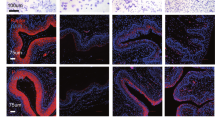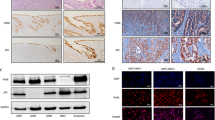Abstract
Numerous studies support a role of phosphatase and tensin homolog deleted from chromosome 10 (Pten) as a tumor suppressor gene that controls epithelial cell homeostasis to prevent tumor formation. Mouse vaginal epithelium cyclically exhibits cell proliferation and differentiation in response to estrogen and provides a unique model for analyzing homeostasis of stratified squamous epithelia. We analyzed vaginal epithelium-specific Pten conditional knockout (CKO) mice to provide new insights into Pten/phosphoinositide-3-kinase (PI3K)/Akt function. The vaginal epithelium of ovariectomized (OVX) mice (control) was composed of 1–2 layers of cuboidal cells, whereas OVX CKO mice exhibited epithelial hyperplasia in the suprabasal cells with increased cell mass and mucin production. This is possibly due to misactivation of mammalian target of rapamycin and mitogen-activated protein kinase. Intriguingly, estrogen administration to OVX Pten CKO mice induced stratification and keratinized differentiation in the vaginal epithelium, as in estrogen-treated controls. We found that Pten is exclusively expressed in the suprabasal cells in the absence of estrogens, whereas estrogen administration induced Pten expression in the basal cells. This suggests that Pten acts to prevent excessive cell proliferation as in the case of other squamous tissues. Thus, Pten exhibits a dual role on the control of vaginal homeostasis, depending on whether estrogens are present or absent. Our results provide new insights into how Pten functions in tissue homeostasis.
This is a preview of subscription content, access via your institution
Access options
Subscribe to this journal
Receive 50 print issues and online access
$259.00 per year
only $5.18 per issue
Buy this article
- Purchase on Springer Link
- Instant access to full article PDF
Prices may be subject to local taxes which are calculated during checkout








Similar content being viewed by others
References
Suzuki A, Itami S, Ohishi M, Hamada K, Inoue T, Komazawa N, et al. Keratinocyte-specific Pten deficiency results in epidermal hyperplasia, accelerated hair follicle morphogenesis and tumor formation. Cancer Res 2003; 63: 674–681.
Blanco V, Keochgerian V . Cowden's syndrome. Case report, with reference to an affected family. Med Oral Patol Oral Cir Bucal 2006; 11: E12–E16.
Leao JC, Batista V, Guimaraes PB, Belo J, Porter SR . Cowden's syndrome affecting the mouth, gastrointestinal, and central nervous system: a case report and review of the literature. Oral Surg Oral Med Oral Pathol Oral Radiol Endod 2005; 99: 569–572.
Yoo LI, Liu DW, Le Vu S, Bronson RT, Wu H, Yuan J . Pten deficiency activates distinct downstream signaling pathways in a tissue-specific manner. Cancer Res 2006; 66: 1929–1939.
Buchanan DL, Kurita T, Taylor JA, Lubahn DB, Cunha GR, Cooke PS . Role of stromal and epithelial estrogen receptors in vaginal epithelial proliferation, stratification, and cornification. Endocrinology 1998; 139: 4345–4352.
Cooke PS, Buchanan DL, Young P, Setiawan T, Brody J, Korach KS, et al. Stromal estrogen receptors mediate mitogenic effects of estradiol on uterine epithelium. Proc Natl Acad Sci USA 1997; 94: 6535–6540.
Nelson KG, Sakai Y, Eitzman B, Steed T, McLachlan J . Exposure to diethylstilbestrol during a critical developmental period of the mouse reproductive tract leads to persistent induction of two estrogen-regulated genes. Cell Growth Differ 1994; 5: 595–606.
Miyagawa S, Katsu Y, Watanabe H, Iguchi T . Estrogen-independent activation of erbBs signaling and estrogen receptor alpha in the mouse vagina exposed neonatally to diethylstilbestrol. Oncogene 2004; 23: 340–349.
Miyagawa S, Suzuki A, Katsu Y, Kobayashi M, Goto M, Handa H, et al. Persistent gene expression in mouse vagina exposed neonatally to diethylstilbestrol. J Mol Endocrinol 2004; 32: 663–677.
Ghahary A, Chakrabarti S, Murphy LJ . Localization of the sites of synthesis and action of insulin-like growth factor-I in the rat uterus. Mol Endocrinol 1990; 4: 191–195.
Ignar-Trowbridge DM, Nelson KG, Bidwell MC, Curtis SW, Washburn TF, McLachlan JA, et al. Coupling of dual signaling pathways: epidermal growth factor action involves the estrogen receptor. Proc Natl Acad Sci USA 1992; 89: 4658–4662.
Nelson KG, Takahashi T, Bossert NL, Walmer DK, McLachlan JA . Epidermal growth factor replaces estrogen in the stimulation of female genital-tract growth and differentiation. Proc Natl Acad Sci USA 1991; 88: 21–25.
Daikoku T, Hirota Y, Tranguch S, Joshi AR, DeMayo FJ, Lydon JP, et al. Conditional loss of uterine Pten unfailingly and rapidly induces endometrial cancer in mice. Cancer Res 2008; 68: 5619–5627.
Joshi A, Ellenson LH . Adenovirus mediated homozygous endometrial epithelial Pten deletion results in aggressive endometrial carcinoma. Exp Cell Res 2011; 317: 1580–1589.
Kim TH, Franco HL, Jung SY, Qin J, Broaddus RR, Lydon JP, et al. The synergistic effect of Mig-6 and Pten ablation on endometrial cancer development and progression. Oncogene 2010; 29: 3770–3780.
Memarzadeh S, Zong Y, Janzen DM, Goldstein AS, Cheng D, Kurita T, et al. Cell-autonomous activation of the PI3-kinase pathway initiates endometrial cancer from adult uterine epithelium. Proc Natl Acad Sci USA 2010; 107: 17298–17303.
Moll R, Franke WW, Schiller DL, Geiger B, Krepler R . The catalog of human cytokeratins: patterns of expression in normal epithelia, tumors and cultured cells. Cell 1982; 31: 11–24.
Gimenez-Conti IB, Lynch M, Roop D, Bhowmik S, Majeski P, Conti CJ . Expression of keratins in mouse vaginal epithelium. Differentiation 1994; 56: 143–151.
Yang A, Schweitzer R, Sun D, Kaghad M, Walker N, Bronson RT, et al. P63 is essential for regenerative proliferation in limb, craniofacial and epithelial development. Nature 1999; 398: 714–718.
Mills AA, Zheng B, Wang XJ, Vogel H, Roop DR, Bradley A . P63 is a p53 homologue required for limb and epidermal morphogenesis. Nature 1999; 398: 708–713.
Bodine SC, Stitt TN, Gonzalez M, Kline WO, Stover GL, Bauerlein R, et al. Akt/mTOR pathway is a crucial regulator of skeletal muscle hypertrophy and can prevent muscle atrophy in vivo. Nat Cell Biol 2001; 3: 1014–1019.
Rommel C, Bodine SC, Clarke BA, Rossman R, Nunez L, Stitt TN, et al. Mediation of IGF-1-induced skeletal myotube hypertrophy by PI(3)K/Akt/mTOR and PI(3)K/Akt/GSK3 pathways. Nat Cell Biol 2001; 3: 1009–1013.
Pende M, Kozma SC, Jaquet M, Oorschot V, Burcelin R, Le Marchand-Brustel Y, et al. Hypoinsulinaemia, glucose intolerance and diminished beta-cell size in S6K1-deficient mice. Nature 2000; 408: 994–997.
Kurita T, Medina RT, Mills AA, Cunha GR . Role of p63 and basal cells in the prostate. Development 2004; 131: 4955–4964.
Lee HW, Ahn DH, Crawley SC, Li JD, Gum JR Jr., Basbaum CB, et al. Phorbol 12-myristate 13-acetate up-regulates the transcription of MUC2 intestinal mucin via Ras. ERK, and NF-kappa B. J Biol Chem 2002; 277: 32624–32631.
Li JD, Feng W, Gallup M, Kim JH, Gum J, Kim Y, et al. Activation of NF-kappaB via a Src-dependent Ras-MAPK-pp90rsk pathway is required for Pseudomonas aeruginosa-induced mucin overproduction in epithelial cells. Proc Natl Acad Sci USA 1998; 95: 5718–5723.
Vilgelm A, Lian Z, Wang H, Beauparlant SL, Klein-Szanto A, Ellenson LH, et al. Akt-mediated phosphorylation and activation of estrogen receptor alpha is required for endometrial neoplastic transformation in Pten+/− mice. Cancer Res 2006; 66: 3375–3380.
Lannigan DA . Estrogen receptor phosphorylation. Steroids 2003; 68: 1–9.
Campbell RA, Bhat-Nakshatri P, Patel NM, Constantinidou D, Ali S, Nakshatri H . Phosphatidylinositol 3-kinase/AKT-mediated activation of estrogen receptor alpha: a new model for anti-estrogen resistance. J Biol Chem 2001; 276: 9817–9824.
Squarize CH, Castilho RM, Gutkind JS . Chemoprevention and treatment of experimental Cowden's disease by mTOR inhibition with rapamycin. Cancer Res 2008; 68: 7066–7072.
Klotz DM, Hewitt SC, Ciana P, Raviscioni M, Lindzey JK, Foley J et al. Requirement of estrogen receptor-alpha in insulin-like growth factor-1 (IGF-1)-induced uterine responses and in vivo evidence for IGF-1/estrogen receptor cross-talk. J Biol Chem 2002; 277: 8531–8537.
Joshi A, Wang H, Jiang G, Douglas W, Chan JS, Korach KS, et al. Endometrial tumorigenesis in Pten(+/−) mice is independent of coexistence of estrogen and estrogen receptor alpha. Am J Pathol 2012; 180: 2536–2547.
Brake T, Lambert PF . Estrogen contributes to the onset, persistence, and malignant progression of cervical cancer in a human papillomavirus-transgenic mouse model. Proc Natl Acad Sci USA 2005; 102: 2490–2495.
Ozawa S, Iguchi T, Sawada K, Ohta Y, Takasugi N, Bern HA . Postnatal vaginal nodules induced by prenatal diethylstilbestrol treatment correlate with later development of ovary-independent vaginal and uterine changes in mice. Cancer Lett 1991; 58: 167–175.
Segrelles C, Moral M, Lara MF, Ruiz S, Santos M, Leis H, et al. Molecular determinants of Akt-induced keratinocyte transformation. Oncogene 2006; 25: 1174–1185.
Shaw RJ, Ras Cantley LC . PI(3)K and mTOR signalling controls tumour cell growth. Nature 2006; 441: 424–430.
Majumder PK, Febbo PG, Bikoff R, Berger R, Xue Q, McMahon LM, et al. mTOR inhibition reverses Akt-dependent prostate intraepithelial neoplasia through regulation of apoptotic and HIF-1-dependent pathways. Nat Med 2004; 10: 594–601.
Neshat MS, Mellinghoff IK, Tran C, Stiles B, Thomas G, Petersen R, et al. Enhanced sensitivity of PTEN-deficient tumors to inhibition of FRAP/mTOR. Proc Natl Acad Sci USA 2001; 98: 10314–10319.
Platz CE, Benda JA . Female genital tract cancer. Cancer 1995; 75: 270–294.
Mudhar HS, Smith JH, Tidy J . Primary vaginal adenocarcinoma of intestinal type arising from an adenoma: case report and review of the literature. Int J Gynecol Pathol 2001; 20: 204–209.
McCluggage WG, Price JH, Dobbs SP . Primary adenocarcinoma of the vagina arising in endocervicosis. Int J Gynecol Pathol 2001; 20: 399–402.
Ebrahim S, Daponte A, Smith TH, Tiltman A, Guidozzi F . Primary mucinous adenocarcinoma of the vagina. Gynecol Oncol 2001; 80: 89–92.
Herbst AL, Ulfelder H, Poskanzer DC . Adenocarcinoma of the vagina. Association of maternal stilbestrol therapy with tumor appearance in young women. N Engl J Med 1971; 284: 878–881.
Tarutani M, Itami S, Okabe M, Ikawa M, Tezuka T, Yoshikawa K, et al. Tissue-specific knockout of the mouse Pig—a gene reveals important roles for GPI-anchored proteins in skin development. Proc Natl Acad Sci USA 1997; 94: 7400–7405.
Groszer M, Erickson R, Scripture-Adams DD, Lesche R, Trumpp A, Zack JA, et al. Negative regulation of neural stem/progenitor cell proliferation by the Pten tumor suppressor gene in vivo. Science 2001; 294: 2186–2189.
Acknowledgements
We thank Dr J Takeda, Osaka University, Suita, Japan, for providing K5-Cre mice. We also thank Dr Y Mikami, Kyoto University, Kyoto, Japan, and Dr Bruce Blumberg, University of California, Irvine, CA, USA, for their support. This study was supported by Grant-in-Aid for Young Scientists B, Grant-in-Aid for Scientific Research B from the Ministry of Education, Culture, Sports, Science and Technology of Japan, and Health Sciences Research Grant from the Ministry of Health, Labour and Welfare, Japan.
Author information
Authors and Affiliations
Corresponding author
Ethics declarations
Competing interests
The authors declare no conflict of interest.
Additional information
Supplementary Information accompanies this paper on the Oncogene website
Rights and permissions
About this article
Cite this article
Miyagawa, S., Sato, M., Sudo, T. et al. Unique roles of estrogen-dependent Pten control in epithelial cell homeostasis of mouse vagina. Oncogene 34, 1035–1043 (2015). https://doi.org/10.1038/onc.2014.62
Received:
Revised:
Accepted:
Published:
Issue Date:
DOI: https://doi.org/10.1038/onc.2014.62
This article is cited by
-
The role of mesenchymal estrogen receptor 1 in mouse uterus in response to estrogen
Scientific Reports (2023)
-
mTORC1 signaling pathway integrates estrogen and growth factor to coordinate vaginal epithelial cells proliferation and differentiation
Cell Death & Disease (2022)



